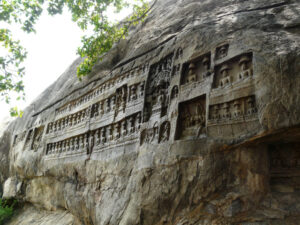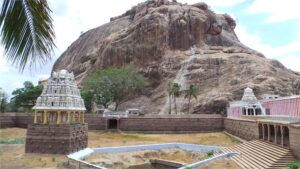
Kalugumalai is a panchayat town in Kovilpatti Taluk of Thoothukudi district in the Indian state of Tamil Nadu.
There are three main Cave Temples in Kalugumalai.
1. Jaina Abode

The area is known for the Jain cave temple and architecture. There are a number of Jain images with labels in vattezhuthu script. There are many relief sculptures dating to the 8th-9th century A.D. in the area, including the rock cut image of Bhagawan Parshwanatha flanked by two Yaksha, as well as many other rock cut images of other tirthankaras.
The epigraphs mention the name of the donors, of the figures, of the provisions made for the offerings, etc. The main deity of the hill was called Araimalai Alwar. The other figures were caused to be made by the followers of Jain faith from a number of villages nearby.
The sculptures were caused to be made in memory of the departed souls. There are approximately one hundred and fifty relief sculptures. Among the donors were the carpenters, potters, smiths, cultivators and other workers. A number of others were high ranking persons bearing the titles of Enadi, Etti and Kavidi. Provisions are also recorded for expounding Jain siddhanta a Gunasagara bhattara a great Jain ascetic lived here. The sculptures and the epigraphs are to be assigned to the reign of Pandya, Parantaka Nedunjadaiya (A.D768-800). From different epigraphies it is found that they belong to different era and the place became extinct after 13th century due to loss of patronage after Pandya kings.
2. Vettuvan Koil

Vettuvan Koil (English: a Sculptor’s paradise) is a Hindu temple built between the 8th and 9th century. Kalugumalai is a priceless unfinished Pandyan monolith cave temple, part of the iconographic richness that helped chronicle the burgeoning richness of the Tamil culture, traditions, and sacred centers containing religious art. About 7.5 meter of the mountain is excavated in a rectangular fashion and in the middle the temple is sculpted from a single piece of rock. The carvings reflect the southern temple style of the Pandya era. Only the top portion of the temple is completed.
The temple has an entrance and centre hall for the main deity. In the later days Ganesha’s idol was kept and worshipped. At the top of the temple beautiful sculpture of Uma Maheswarar, Dakshinamoorthy, Vishnu and Brahma can be found. This temple is of same style of Kailasnath temple in Ellora, structural shrines at Pattadakal in Bijapur, monolithic temples of Pallavas at Mamallapuram showing the close political relationship between Pallavas, Chalukyas and Rashtrakutas. There are around 122 sculptures in the rock cut temple. The intricately carved statues are from fine granite.
3. Kalugasalamoorthy temple 
The main deity of this temple is Murugan. The main deity hall and entrance hall is excavated inside the foot hills of Kalugumalai in the south western corner of the hill and with external structural additions.
The temple has many aesthetic sculptures. The temple dates to 18th century. The main deity is Lord Murugan with his wife Devyanai. The temple complex also has shrines of Shiva, Akilandeswari, Vinayakar and many lesser deities.
Source:
http://en.wikipedia.org/wiki/Kalugumalai
http://sarsonkekhet.in/2013/11/22/tamil-nadu-temple-run-kalugumalai/


